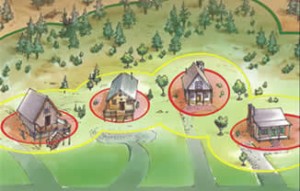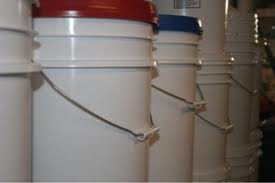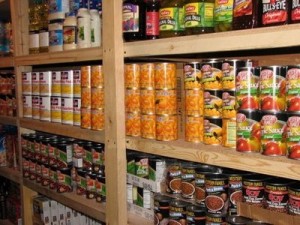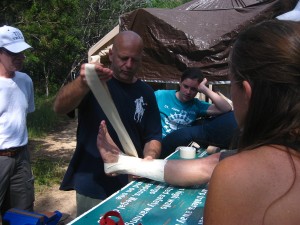Urban Survival at Home (Bugging In)
 Much of the hype around preparedness and urban survival focuses on the concept of the “bug-out” bag and its various incarnations; and why not? It’s a much simpler concept to wrap one’s head around than all the preparation involved in setting up your home as the spot you intend to stay in a post-disaster or even post-SHTF scenario. We teach bug-out scenarios, caches, escape and evasion and much more related to bugging out at my survival school – The Human Path – and it is important to know the full range of skills and equipment and realities around every aspect of bugging out.
Much of the hype around preparedness and urban survival focuses on the concept of the “bug-out” bag and its various incarnations; and why not? It’s a much simpler concept to wrap one’s head around than all the preparation involved in setting up your home as the spot you intend to stay in a post-disaster or even post-SHTF scenario. We teach bug-out scenarios, caches, escape and evasion and much more related to bugging out at my survival school – The Human Path – and it is important to know the full range of skills and equipment and realities around every aspect of bugging out.
 But the cold reality remains that “bugging out” should be your absolute last resort. If you have spent any time and money at all on preparing your home (or even if you haven’t), your chances of roughing it through a disaster at home are still much better than driving, biking or walking out on your own (or in a group) – possibly to a destination that is a worse situation than the one you are leaving.
But the cold reality remains that “bugging out” should be your absolute last resort. If you have spent any time and money at all on preparing your home (or even if you haven’t), your chances of roughing it through a disaster at home are still much better than driving, biking or walking out on your own (or in a group) – possibly to a destination that is a worse situation than the one you are leaving.
While it’s of course a great idea to have a bug-out location and bug-out bag (or a set of them), along with “get-home” bags in the car (probably a better initial investment in time and money), I’d like to walk through some of the major points of prepping your own domicile and hopefully even your neighborhood for a post-SHTF situation.
If it’s not already obvious, one of the nice things about survival is that “simple” is almost always best. In this regard, let’s look to the basic necessities of survival and determine how we can fulfill those in our own home or apartment. These necessities are typically: Water, Fire, Food, Shelter and Security. For instance, one of the first things that students have to do at our Urban Core Basic (urban survival) course is to work as a team figuring out their resources from scrap and salvage spread all over about 5 acres from a “hurricane.” Students work on what they learned in class to be able to create decent, secure shelters (that they can and will have to sleep in) in a minimum of time, while figuring out their resources and knowledge in the team.
 However, in an urban survival environment, these 5 necessities can be broken down in many ways, even if the end result is somewhat the same. In an urban area (especially assuming we have done some preparation) the essential concepts we are looking for can also be divided into Water, Food, Power, Light, Health and Security. Some of these areas are pretty basic and simple, and some can become very complex depending on what resources you have. This article is an overview and has to stay at the “10,000 foot” level, but bear in mind that every topic listed below would merit at least one if not more separate articles to get into more detail. As an overview then, here is how the essentials can be broken down:
However, in an urban survival environment, these 5 necessities can be broken down in many ways, even if the end result is somewhat the same. In an urban area (especially assuming we have done some preparation) the essential concepts we are looking for can also be divided into Water, Food, Power, Light, Health and Security. Some of these areas are pretty basic and simple, and some can become very complex depending on what resources you have. This article is an overview and has to stay at the “10,000 foot” level, but bear in mind that every topic listed below would merit at least one if not more separate articles to get into more detail. As an overview then, here is how the essentials can be broken down:
1)  Water: Here is where I think a lot of people miscalculate. Work on water before you try to tackle anything else. It’s easy to set yourself up, and doesn’t require a lot of financial investment. Nonetheless most people woefully underestimate the amount of water they’ll need and don’t think specifically about all the reasons they’ll need it:
Water: Here is where I think a lot of people miscalculate. Work on water before you try to tackle anything else. It’s easy to set yourself up, and doesn’t require a lot of financial investment. Nonetheless most people woefully underestimate the amount of water they’ll need and don’t think specifically about all the reasons they’ll need it:
a. Water to drink – Duh… of course, right? But how much? Count on a minimum of 1 gallon per day per person for drinking. This is more than you likely need to survive at a bare minimum indoors, but plan on using that much drinking water anyway, because it doesn’t take that much room or money to do so, and because you’ll be glad you did if you have more than you end up needing for drinking water. As a backup water plan, you should also invest in at least one water filtration system (for example: Berkey water filters), and one or more of the numerous and inexpensive, portable bugout-bag systems. However the first and most important thing to start with is having a supply of water that does not need filtration or boiling/distilling. One easy way to do this is to invest in several 55-gallon, food-grade plastic barrels. These range from about $25 – $50 depending on whether they are new or used, and whether they already have a spout at the bottom or not. Alternatively, the 5-gallon plastic water containers you can buy for about $5-$8 will work as well, stacked neatly so they don’t take up much room.
b. Water for sanitation – Most people don’t really think about this. Disasters like hurricanes, tornadoes, floods, earthquakes make an enormous mess of sewage, salt-water (near the coast), agricultural waste, and lots more. This means that even a minor injury can become life or limb threatening. Especially if medical care is limited. Water for washing off (shower), cleaning your teeth, water for cleaning wounds and other first aid, water for helping clean and take care of toilet needs, whether that amounts to 5-gallon buckets, trash bags, or a trench in your back yard.
c. Water for food – If you’re growing your own food, then you will need water for that. Very little water in urban areas is gravity-fed, so a power outage means no water to your home or to your garden, greenhouse, etc. How much water does it take to keep your food growing? Do you know? One way to track it is to set up a gravity drip system with PVC and a 35 or 55 gallon drum. It doesn’t cost much, saves a lot of water, and is very simple to set up. Rainwater collection or other sources of gray water are also a good plan. Rainwater collection, depending on where you live, is a good plan for drinking water too, but requires specific filtration in that case as well.
2)  Food: You can think in terms of short term, medium term and long term with your food. A lot of prepper outlets will try to sell you on the idea of MRE’s and freeze-dried solutions like Mountain House. These have calories to keep you alive for a short-term disaster (less than a few weeks) but are not, by any stretch of the imagination, real food for the medium or long haul. For longer term food supplies, start with extremely inexpensive with foods like beans (red beans, lentils, etc.) and rice. Build up from there using food drying (dehydrators like the Excaliber brand, for instance) dry canning, wet canning, mylar and food-grade storage buckets to package and store your food in vacuum sealed containers that will allow your food supplies to keep for several years. There is much more to this than can be covered in the scope of this article, but to keep it brief, bear in mind that “food fatigue” is a real and imminent concept if you are planning on living on stored food for months or even years. To effectively understand how to work with stored food, you must change your lifestyle as a part of your preparations. This means cooking with your stored food now on some kind of regular basis, rotating through your stores, and most importantly understanding what kinds of food you really need to keep morale and attitude sharp.
Food: You can think in terms of short term, medium term and long term with your food. A lot of prepper outlets will try to sell you on the idea of MRE’s and freeze-dried solutions like Mountain House. These have calories to keep you alive for a short-term disaster (less than a few weeks) but are not, by any stretch of the imagination, real food for the medium or long haul. For longer term food supplies, start with extremely inexpensive with foods like beans (red beans, lentils, etc.) and rice. Build up from there using food drying (dehydrators like the Excaliber brand, for instance) dry canning, wet canning, mylar and food-grade storage buckets to package and store your food in vacuum sealed containers that will allow your food supplies to keep for several years. There is much more to this than can be covered in the scope of this article, but to keep it brief, bear in mind that “food fatigue” is a real and imminent concept if you are planning on living on stored food for months or even years. To effectively understand how to work with stored food, you must change your lifestyle as a part of your preparations. This means cooking with your stored food now on some kind of regular basis, rotating through your stores, and most importantly understanding what kinds of food you really need to keep morale and attitude sharp.
 Any real long-term food storage plan is completely amiss without the concept of gardening and backyard livestock (chickens, rabbits, etc.) as an integral part of it. This doesn’t mean buying a can of heirloom seeds and storing them at the back of your pantry and then forgetting about it. This means actively gardening now. Raising food to live on takes work and most of all experience. Understanding soil health, composting, vermiculture, droughts, insects, disease, harvesting, winter gardening, seed harvesting and so forth are all necessary experience that goes into long-term food preparation. Not having any experience with a garden and expecting your non-hybrid seeds to fulfill this part of your plan is like reading about starting a friction fire using a hand-drill and then assuming you can do it on that day when it’s 38 degrees F and drizzling and you’re almost hypothermic. There is no substitution for practice, and nothing you can read will take the place of experiencing what is necessary work in order to create a garden you can actually use as food. Subjects that spin off of this topic include: Raised bed gardening, wicking beds, aquaponics, permaculture, vertical and forest gardening. If you are interested in plant medicines, consider growing those as well. I commonly talk about herbalism on my podcast and blogs, and teach this subject at my school to help pass on this kind of information. Medicinal plants are as important in my own gardens as food is.
Any real long-term food storage plan is completely amiss without the concept of gardening and backyard livestock (chickens, rabbits, etc.) as an integral part of it. This doesn’t mean buying a can of heirloom seeds and storing them at the back of your pantry and then forgetting about it. This means actively gardening now. Raising food to live on takes work and most of all experience. Understanding soil health, composting, vermiculture, droughts, insects, disease, harvesting, winter gardening, seed harvesting and so forth are all necessary experience that goes into long-term food preparation. Not having any experience with a garden and expecting your non-hybrid seeds to fulfill this part of your plan is like reading about starting a friction fire using a hand-drill and then assuming you can do it on that day when it’s 38 degrees F and drizzling and you’re almost hypothermic. There is no substitution for practice, and nothing you can read will take the place of experiencing what is necessary work in order to create a garden you can actually use as food. Subjects that spin off of this topic include: Raised bed gardening, wicking beds, aquaponics, permaculture, vertical and forest gardening. If you are interested in plant medicines, consider growing those as well. I commonly talk about herbalism on my podcast and blogs, and teach this subject at my school to help pass on this kind of information. Medicinal plants are as important in my own gardens as food is.
3) Power: Basically you need power for at least four very important things. Depending on where you live, two of them are very important for food, hygiene and possibly water, as well as comfort or possibly even survival (in the far north). The other two are important for security and is a very nice “luxury” to have. Those four things I am referring to are: Heat, cooling, light and communication.
a. Heating and Cooling: Start with backup methodologies for heating and cooling your food that do not require power and make sure they are in place. Then, once you have at least one off-grid power source (such as wind, solar, hydroelectric, generator, etc.) then you still have the non-power version as a backup method. Examples of non-power sources of heating would be outdoor BBQ grills, fireplaces, fire pits & burn barrels. Examples of non-power sources of cooling food are root cellars, clay pot evaporative cooling, natural water or cooling (streams, creeks, springs, snow, etc.) and easy/cheap variations of underground food storage such as buried 55-gallon drums. From there, move into getting power sources set up using generators (diesel, propane, gasoline, tri-fuel adapter kits, etc.) first, followed by DC off-grid sources like wind, water, sun, etc.
b. Light: The easy start on this is making sure you have candles and flashlights or other battery-powered lighting. Hand-crank and solar powered LED lighting is also extremely cheap as a backup solution.
c. Communication: Along with the above power sources, look at charging up your peripherals like cell-phone, laptops, radio, etc., with backup charging and DC power sources that can be achieved using very common, inexpensive accessories, such as small solar chargers and small (300-1000W) inverters that will run off of a car engine (cigarette lighter or battery).
4)  Health: Make sure you have a first aid kit packed for the house, for the car, and for your bugout bag(s). These are different size kits in my own household that range from a medium sized backpack down to something I can throw in my pants cargo pocket and go. Always be looking for cheap containers to hold first aid kits and supplies for these different types of kits. More important than the first aid kit itself is knowing how to use the first aid kit! Included in this is knowing where the items in your first aid kit are, while under stress. It’s one thing to search for some gauze and an ace wrap at a leisurely pace, and quite another, under low-light conditions, with someone screaming and in shock (especially someone you care about) bleeding out bright-red, pulsing blood while you fumble in the dark trying to remember anything at all, much less where exactly you put the ace wraps. I prefer first aid kits that fold straight out so that they can be hung up on a tree limb or a coat hanger, or just laid out on the floor so that I don’t have to dig through layers of items to get at something near the bottom of the bag. Whatever your kit contains, use it. You should be rotating supplies through your kit anyway so that it doesn’t just sit and decay. Use it every chance you get. Even for minor “boo-boos.” If you have time, turn out all the lights, open the bag and throw it into the middle of the floor before trying to find what you need. Always practice this kind of thing in Ft. Living Room or Ft. Backyard if you have the chance. It will truly help you when you really need to use skills like first aid, under pressure. This will also help you in building your own first aid kits as you realize what is useful and what is garbage. Don’t buy pre-made first aid kits unless you have no other choice in the matter.
Health: Make sure you have a first aid kit packed for the house, for the car, and for your bugout bag(s). These are different size kits in my own household that range from a medium sized backpack down to something I can throw in my pants cargo pocket and go. Always be looking for cheap containers to hold first aid kits and supplies for these different types of kits. More important than the first aid kit itself is knowing how to use the first aid kit! Included in this is knowing where the items in your first aid kit are, while under stress. It’s one thing to search for some gauze and an ace wrap at a leisurely pace, and quite another, under low-light conditions, with someone screaming and in shock (especially someone you care about) bleeding out bright-red, pulsing blood while you fumble in the dark trying to remember anything at all, much less where exactly you put the ace wraps. I prefer first aid kits that fold straight out so that they can be hung up on a tree limb or a coat hanger, or just laid out on the floor so that I don’t have to dig through layers of items to get at something near the bottom of the bag. Whatever your kit contains, use it. You should be rotating supplies through your kit anyway so that it doesn’t just sit and decay. Use it every chance you get. Even for minor “boo-boos.” If you have time, turn out all the lights, open the bag and throw it into the middle of the floor before trying to find what you need. Always practice this kind of thing in Ft. Living Room or Ft. Backyard if you have the chance. It will truly help you when you really need to use skills like first aid, under pressure. This will also help you in building your own first aid kits as you realize what is useful and what is garbage. Don’t buy pre-made first aid kits unless you have no other choice in the matter.
Just as important as first aid is sanitation. If the power and water go out in your house, how are you going to take care of human waste? Solutions can range from 5-gallon buckets and lime indoors to trenches outdoors, to humanure composting, solar and other composting toilets, outhouses and more. The primary thing is to have at least one plan for this and not wait until it’s actually an issue before starting your plan.
5) Security: One of the biggest misunderstandings in regards to bug-in security in your own home is that a home is a defensible structure by itself. Unless you have designed your home specifically in regards to its location, the terrain around it, the home itself, windows, doors, fields of fire, exits, etc., you most likely do not have a defendable home if even a small group of armed, well-trained individuals want to attack it.
The first thing to consider is that if someone actually makes it into your home, you’ve already lost the security contest. Security starts in a radius of several hundred meters around your home, ideally. This is why, in an urban or suburban area, you should really start thinking about neighborhood security as much as home security. Neighborhoods can be much easier to secure, as the perimeter can be observed and secured by many more people. Additionally, putting up barriers for foot traffic as well as cutting down on high-speed avenues of approach and funneling traffic in and out of the neighborhood greatly increases the overall securability of not only a large area, but each individual house as well.
Obviously, securing a neighborhood requires a lot of community involvement both before as well as during and after a disaster happens. Just getting to know your neighbors on any level is a good way to start in on this task. This is helpful even for day-to-day security issues such as your neighbors knowing cars or people who would or would not be possible criminals intent on stealing or otherwise invading your domicile.
Back to securing your own house, however, there are things you can do to at least increase security in and around your home and yard. If you have a large yard, consider motion detectors in areas that are difficult to observe. Figure out the best vantage points both in and around your own home, and what the best, concealed routes to and from those vantage points are. Consider stocking up on plywood and nails or screws, and storing them in an easily accessible area from inside the house. This allows you to at least be able to block off windows (and doors) from easy entrance, as well as provide concealment and even some minimal cover from weapons fire. If you’re even more serious about security from weapons fire, look into stocking up on cinder blocks as well.
The main thing to think about is an egress out of your house and neighborhood if things were to really heat up to the point that plywood or cinder blocks were going to actually be called for.
For this reason, I’m not the biggest fan of turning your home into a bunker. Frankly, if a force really wants to take your home, they’re probably going to be able to do it. From the psychological stress of waiting you out, to burning you out, to a multitude of other tricks (pumping insecticide in through a window, smoke, etc.), your best defense again is neighborhood security. In absence of that, your next best defense is good Intel and awareness of what might be coming your way so that you can prepare or even bugout accordingly. This would then (in absence of neighborhood and community security) fall on to the shoulders of good radio (HAM, scanners, etc.) communications and the vantage points talked about earlier. Listening Posts/Observation Posts (LP/OP) is the military term for static reconnaissance points around an area. This kind of information is every bit as important as trying to bunker into your own home ahead of time.
In closing, remember the “4 A’s” as I like to teach in my urban and primitive survival classes:
Attitude, Awareness, Adaptability and Accountability.
Use these “A’s” as an infrastructure that you build all of your skills and supplies around.
Attitude: You can’t survive anything if your attitude is not in the right place. Your mind is your greatest tool and weapon, and attitude is the lubricant that allows it to work correctly.
Awareness: Being aware of what is going on around you is a huge part of security, as mentioned before. It requires much less energy to avoid a situation than to try and get out of one.
Adaptability: You have to be able to use your skills and common sense to be adaptable because there is no way to predict everything that can happen, much less plan for every possible scenario.
Accountability: Being accountable is essential on every level for proper leadership and teamwork, which itself necessary for survival. Being prepared for a disaster is not a lone-wolf activity. It is a team or community effort, whether just your family or friends, neighbors and surrounding community.
Visit the live broadcast of “The Human Path” every Wednesday 7pm/Est Go Here!
Visit “The Human Path” show page for upcoming shows and archives Go Here!
Accountability Adaptability attitude Awareness bugging in bugging out Food health Power Security The Human Path Urban Survival Water

